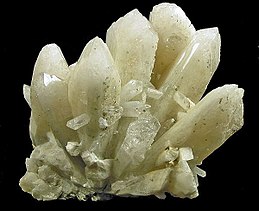Danburite
| Danburite | |
|---|---|
 Cluster of creamy crystals of danburite | |
| General | |
| Category | Tectosilicates |
| Formula (repeating unit) | CaB2(SiO4)2 |
| IMA symbol | Dbu[1] |
| Strunz classification | 9.FA.65 |
| Dana classification | 56.3.1.1 |
| Crystal system | Orthorhombic |
| Crystal class | Dipyramidal (mmm) H-M symbol: (2/m 2/m 2/m) |
| Space group | Pnam |
| Unit cell | a = 8.038(3), b = 8.752(5) c = 7.73 [Å]; Z = 4 |
| Identification | |
| Colour | Colourless, white, gray, brownish white, straw yellow |
| Crystal habit | Euhedral prismatic crystals; disseminated masses |
| Cleavage | {001} Poor |
| Fracture | Subconchoidal to uneven |
| Tenacity | Brittle |
| Mohs scale hardness | 7 – 7.5 |
| Lustre | Vitreous to greasy |
| Streak | White |
| Diaphaneity | Transparent to translucent |
| Specific gravity | 2.93 – 3.02 |
| Optical properties | Biaxial (+/-) |
| Refractive index | nα = 1.627 – 1.633 nβ = 1.630 – 1.636 nγ = 1.633 – 1.639 |
| Birefringence | δ = 0.006 |
| 2V angle | 88 to 90° measured |
| Dispersion | r < v strong |
| Ultraviolet fluorescence | Fluorescent and thermoluminescent (red); Short UV=violet blue; Long UV=blue to blue-green |
| References | [2][3][4] |
Danburite is a calcium boron silicate mineral with a chemical formula of CaB2(SiO4)2.[5]
It has a Mohs hardness of 7 to 7.5 and a specific gravity of 3.0.[5] The mineral has an orthorhombic crystal form.[5] It is usually colourless, like quartz, but can also be either pale yellow[5] or yellowish-brown. It typically occurs in contact metamorphic rocks.
The Dana classification of minerals categorizes danburite as a sorosilicate, while the Strunz classification scheme lists it as a tectosilicate;[4] its structure can be interpreted as either.
Its crystal symmetry and form are similar to topaz; however, topaz is a calcium fluorine bearing nesosilicate. The clarity, resilience, and strong dispersion of danburite make it valuable as cut stones for jewelry.
It is named for Danbury, Connecticut, United States, where it was first discovered in 1839 by Charles Upham Shephard.[5]

References
[edit]- ^ Warr, L.N. (2021). "IMA–CNMNC approved mineral symbols". Mineralogical Magazine. 85 (3): 291–320. Bibcode:2021MinM...85..291W. doi:10.1180/mgm.2021.43. S2CID 235729616.
- ^ Danburite data on Webmineral
- ^ "Danburite in The Handbook of Mineralogy" (PDF). Archived from the original (PDF) on 2022-05-11. Retrieved 2014-03-24.
- ^ a b Danburite on Mindat.org
- ^ a b c d e Chisholm, Hugh, ed. (1911). . Encyclopædia Britannica. Vol. 7 (11th ed.). Cambridge University Press. p. 793.
